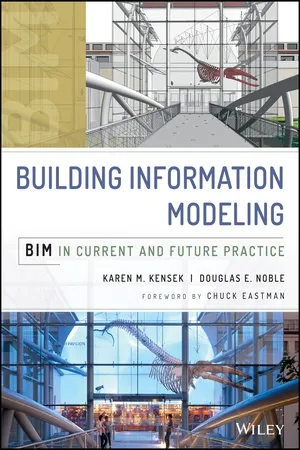1.1 INTRODUCTION
Despite the myth of the heroic architect, popularized by Ayn Rand’s novel The Fountainhead, whose Howard Roark–like designs spring entirely from personal inspiration, architects and engineers need information to design buildings. Few people today question the needs of the clients and/or users so at least a rough program of activity spaces is usually embedded within the design process if it doesn’t precede the actual building design. But there is a lot more information that helps architects make decisions during the design process. While it may not be possible to know everything involved in the design and construction processes prior to the completion of a building, there are assumptions that having information is better than not having it, that informed decisions are better than uninformed ones, and that design is a knowledge-based activity. If one does not object to designing with information that includes maximizing building performance, budgeting, and material optimizations, then building information modeling (BIM), almost by definition, has the potential to improve the products and processes of architectural design.
Building information modeling provides the implied promise of integrating all types of needed data into one file or model (perhaps with separate but linked files with easy bilateral information transfer). While the fulfillment of that promise depends, in part, on both the pace of commercial software development and academic researchers, any current lack of a single integrated information model is not a reason to avoid the process. Furthermore, as long as there are competing products for use by architects, the features and ability to integrate different types of data are likely to vary. As architects are by nature and profession optimists, the type of integrated data and information in this discussion may not (always or currently) be ubiquitously available, but the information not available in the application of choice, may and probably will (or at least should) be part of and contained within any future development.
Tools are needed for form-making, simulation and analysis, and document production. Clearly these tools may be discrete, or they might be combined into one or more separate applications. A value of reducing the number of separate tools is to facilitate the ability to cyclically and iteratively move back and forth between tasks, especially between schematic design (of which form-making is a part) and analysis (which may rely on simulation). Note that none of these relationships assume an artificial intelligence or machine-determined decision-making process. While that may be possible at some point, its desirability is not assumed, and the purpose of using BIM in this case is to use the attributes of computational, information technology-enabled design to provide any member of the building design team with information helpful in making decisions. It is critical to understand, however, that success in the integration of BIM into the design and building delivery process relies, at least in part, on a combination of robust hardware and software.
Digital media in general, and building information modeling in particular, have the ability to inform the very beginning of the design process. The ability to associate data with geometry allows designers to begin to (1) integrate technical and performance criteria at early stages of design thinking while including advanced visualization capabilities and (2) algorithmically and/or iteratively test design implications. BIM starts redefining the way design ideas are generated by bridging formal creativity with design and technological innovation through a close integration of parametric generative tools, through the introduction of physically accurate digital materiality, and through intelligent database-enriched digital objects. Finally, BIM affords the architect (and client) an opportunity to include life-cycle assessment as part of the design process when considering alternatives. As design implementation in BIM becomes more tightly intertwined, there is the potential to combine multiple roles in the design process much in the way that “typists” have been replaced as authors write/type and compose with one tool. BIM also facilitates bridging across disciplinary boundaries.
It now remains to determine the kinds of tools that can facilitate creativity and innovative thinking within the design process. Creativity tools need to provide design feedback, help designers to gain new experiences, and allow for unexpected associations with pattern-breaking functionalities. They need to allow for inductive and lateral thinking, as well as to connect with broader expertise from other building delivery team partners.
Present BIM platforms have a legacy that derives from a combination of early CAD software and visualization applications—all of which are based on geometric logic. The software relies on shapes and forms to delineate architecture. Moreover, there is a proclivity to look at or define a building as a set of parts, components, or “families.” As such, it promotes mainly visually driven design validation in an additive design process. The other component of the current BIM platform, the database, is usually implemented as an extension of geometry, an attribute of a model. It is rarely a part of a broader datascape that considers user behaviors, functional patterns, relationships between the cost and performance, simulation of energy use, or life-cycle analysis. In a design context BIM may be used to evaluate form, to look at generative abilities of parametric models, and as a tool to see how analysis can drive (or at least influence) the building delivery process.
